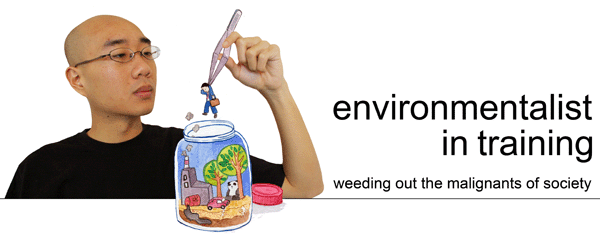How do you fancy spending a Saturday afternoon in a camp an hour away from the city in the middle of nowhere? Sounds relaxing, eh? Well, wait 'til you get there to realize that you have to wear giant waterproof boots, walk in 2-5 feet of water 1 km upstream, electrocute (alright, more of stun) fishes, record their mass and length on a waterproof logbook under lite rain, and calculate the energy flows through trophic zones. If you really wanna know, that's exactly how I spent my precious Saturday afternoon this week.

 You're probably wondering what an environmental and energy policy major such as myself doing in a stream and catching fishes at Sandy Creeks. When Yas heard about this, her initial reaction was, "Woah! You're school really maintains its forestry roots!" (Of course she said it in tagalog. hehe. "maintains" is the closest word I could find for "panindigan") Yeah, that's what I thought so too, until I learned the rationale behind it.
You're probably wondering what an environmental and energy policy major such as myself doing in a stream and catching fishes at Sandy Creeks. When Yas heard about this, her initial reaction was, "Woah! You're school really maintains its forestry roots!" (Of course she said it in tagalog. hehe. "maintains" is the closest word I could find for "panindigan") Yeah, that's what I thought so too, until I learned the rationale behind it.Okay, so here's how it goes. How do you value natural resources? How much are you willing to pay to preserve a primary forest? Let's make it simpler. How much are you willing to pay for the life of a 1-kg salmon? Say 1000 pesos because that's what you would probably pay in a sushi bar. Maybe 300 pesos if you buy it from Farmer's market. Now, do you think that's the true value of a 1-kg salmon? How do you account for the salmon's services in preserving the ecological balance and integrity of the stream? I don't think 300, nor even 1000 pesos, would justify that. That's the sort of conundrum you get yourself into when you try to monetize the value of something that is hard to value in the first place -- like natural resources or a person's well being. You're probably wondering why there's a need for such valuation. Well, here's another example. How much do factories pay to dump carcinogens into our atmosphere? Nil! Governments don't know how much to charge these factories because we don't know what monetary value we can fairly assign for our atmosphere. Biophysical and ecological economists attempt to quantify everything in terms of energy flows in the hope that it would avoid some of the biases of monetized valuation. So again, what's the value of a 1-kg salmon? It may depend on how it affects (and utilizes) the flow of energy in an ecosystem. Cool huh?
 I just wanna show this photo because I find it very interesting and fun. Well, the guy on the left most side is not wearing a ghostbusters proton pack. It's an electric stunner designed to temporarily incapacitate fishes that swim near the probe. Once they get stunned, the 2 other folks collect and put them in a temporary fish tank where another team takes them for physical examination. Unfortunately, some of them are randomly selected to be dissected by standby ichtyologists (fish experts). All for the name of environmental science! You gotta sacrifice some to save the world, I guess.
I just wanna show this photo because I find it very interesting and fun. Well, the guy on the left most side is not wearing a ghostbusters proton pack. It's an electric stunner designed to temporarily incapacitate fishes that swim near the probe. Once they get stunned, the 2 other folks collect and put them in a temporary fish tank where another team takes them for physical examination. Unfortunately, some of them are randomly selected to be dissected by standby ichtyologists (fish experts). All for the name of environmental science! You gotta sacrifice some to save the world, I guess.

No comments:
Post a Comment